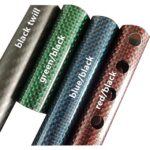Introduzione
In the realm of modern manufacturing, a revolutionary material has emerged, known as Fibra di carbonio CNC. This article aims to shed light on its significance compared to traditional materials. We’ll explore their differences, applications, and how they stack up against each other in terms of performance, cost, and environmental impact.
Understanding CNC Carbon Fiber
What is CNC Carbon Fiber?
CNC carbon fiber is a cutting-edge material characterized by its strength, lightweight, and versatility. Born from the fusion of carbon fiber sheets and precision CNC (Computer Numerical Control) machining, it offers unparalleled precision and flexibility in design.
Processo di produzione
The production of CNC carbon fiber involves layering sheets of carbon fiber and binding them with a resin. These layers are then shaped and cut using CNC machines, ensuring high accuracy and consistency.
Applications and Advantages
CNC carbon fiber finds its use in various sectors, including aerospace, automotive, and sports equipment, owing to its superior strength-to-weight ratio and adaptability.
Overview of Traditional Materials
Common Traditional Materials
Traditional materials like steel, aluminum, and plastics have long been the backbone of manufacturing. Each material brings its own set of properties and uses to the table.
Performance Comparison
Strength and Weight
One of the most striking differences between CNC carbon fiber and traditional materials is the strength-to-weight ratio. CNC carbon fiber outperforms most materials in this aspect, offering high strength with significantly less weight.
Durata e manutenzione
In terms of durability, CNC carbon fiber stands out with its resistance to corrosion and wear, translating to lower maintenance needs compared to some traditional materials.
Precision and Machinability
The precision offered by CNC machining of carbon fiber is unparalleled, providing intricate designs and tight tolerances that are often challenging with traditional materials.
Comparative Applications
Applications in Key Industries
In aerospace and automotive industries, CNC carbon fiber has become increasingly popular for its weight-saving benefits, which translate to better fuel efficiency and performance. In contrast, traditional materials continue to find use in applications where cost or specific material properties are a priority.
Cost-Benefit Analysis
Initial Investment and Long-Term Costs
While the initial investment in CNC carbon fiber might be higher, its durability and low maintenance often result in a favorable long-term cost profile.
ROI and TCO
Analyzing the Return on Investment (ROI) and Total Cost of Ownership (TCO) reveals that CNC carbon fiber, despite its upfront costs, can be more economical in the long run, especially in applications where its unique properties are essential.
Impatto ambientale e sostenibilità
Manufacturing Process Impact
The environmental footprint of producing CNC carbon fiber, though significant, can be mitigated through advances in manufacturing techniques and recycling efforts.
Recyclability and Lifecycle Assessment
Both CNC carbon fiber and traditional materials have varying degrees of recyclability and environmental impact, which are important considerations in lifecycle assessments.
Future Trends and Developments
Innovations in CNC Carbon Fiber
The ongoing technological advancements in CNC carbon fiber promise even wider applications and efficiency improvements in the future.
Traditional Materials’ Evolution
Likewise, traditional materials are not static; ongoing research and development continue to enhance their properties and applications.
Conclusione
In summary, CNC carbon fiber and traditional materials each have their unique strengths and applications. Understanding their differences and respective advantages is crucial for making informed decisions in manufacturing and design.


